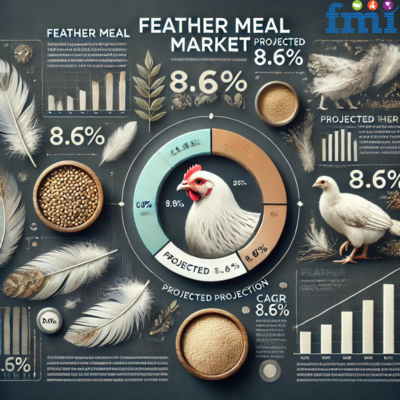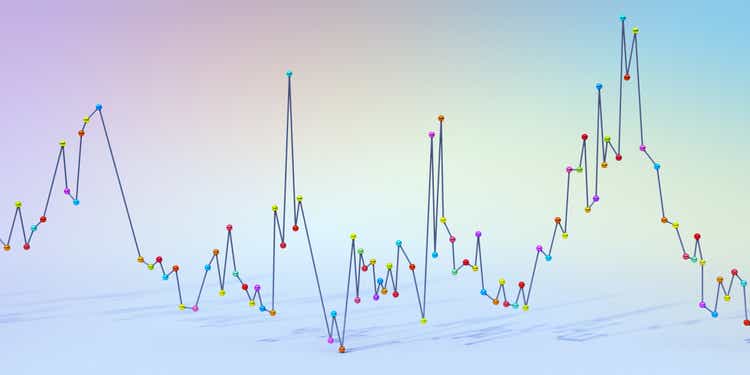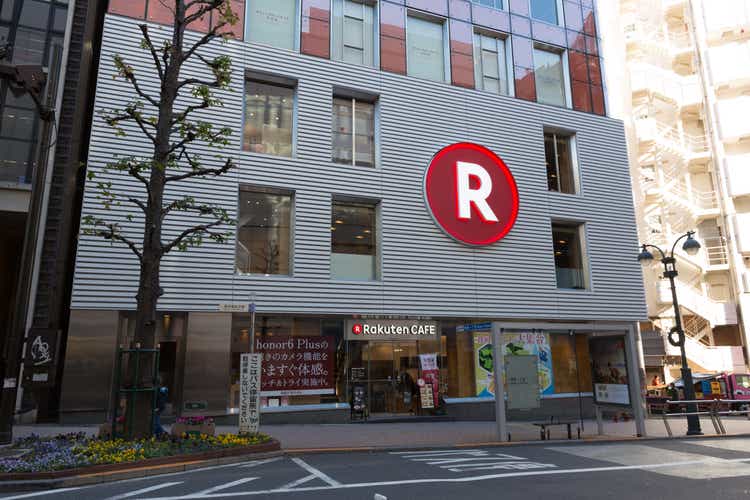
NEWARK, Del, Oct. 30, 2024 (GLOBE NEWSWIRE) -- The feather meal market , valued at USD 570.1 million in 2024, is anticipated to reach USD 1,270.
1 million by 2034, growing at a CAGR of 8.6%. Feather meal, derived from poultry feathers, is a sustainable, protein-rich option for animal feed, fertilizers, and even bioplastics, providing versatile solutions across industries.
With advancements in hydrolysis technology, feather meal is increasingly digestible, boosting its appeal in the animal nutrition sector. Its rich amino acid profile supports livestock health, and its organic nature aligns with the trend toward sustainable farming and eco-friendly practices. The market’s growth is further driven by increased global protein demands in aquaculture, pet food, and animal feed , offering a cost-effective, low-impact alternative to traditional protein sources like fish and soybean meal.
This trend is particularly prominent in regions like North America and Asia-Pacific, where agricultural practices and animal nutrition standards are evolving. Feather meal also finds applications in organic agriculture, where it functions as a nitrogen-rich fertilizer, releasing nutrients gradually and improving soil health over time. Its adoption in horticulture and lawn care reflects its role in promoting environmentally-friendly landscaping practices.
Growth Drivers and Opportunities Key growth drivers for the Feather Meal Market include its cost-efficiency, high protein content, and alignment with sustainability goals in agriculture and animal feed. The rise in organic farming and eco-friendly pet food further expands its application scope. Feather meal also supports a circular economy by repurposing poultry by-products.
Key Takeaways from Market Study : Estimated Market Size (2024) : USD 570.1 million. Forecast Market Size (2034) : USD 1,270.
1 million, growing at an 8.6% CAGR. Main Applications : Animal feed, organic fertilizers, and bioplastics.
Top Growth Regions : North America and Asia-Pacific. “Feather meal’s high protein content and sustainability make it an ideal alternative for animal feed and organic fertilizers, addressing both environmental and economic needs in agriculture,” - says Nandini Roy Choudhury , Client Partner at Future Market Insights Country-wise Insights Key determinants of growth for the Feather Meal Market: High Nutrient Content : Feather meal offers a rich source of protein and nitrogen, making it popular in animal feed and organic fertilizers. Sustainable & Cost-effective Protein Source : As a by-product of the poultry industry, feather meal provides an eco-friendly, low-cost protein source.
Rising Demand for Organic Fertilizers : Increased preference for organic farming boosts demand for feather meal as a natural fertilizer. Growth in Livestock Feed Market : Expanding livestock production drives demand for protein-rich feed, benefiting the feather meal market. Advancements in Processing Technology : Innovations in feather processing improve digestibility and broaden feather meal’s applications.
Stringent Waste Disposal Regulations : Environmental regulations encourage the use of by-products like feather meal, aiding market growth. Growing Awareness of Circular Economy : Demand for sustainable practices in agriculture supports market expansion for feather meal. Read the Complete Report! Feather Meal Market Analysis: Source & End Use to 2034 Competitive Landscape Analysis The feather meal market exhibits a high level of competition, with key players such as Darling Ingredients, Valley Proteins, Inc.
, K-Pro USA, and Kleingarn Agrarprodukte driving industry growth. These leading companies invest significantly in research and development and sustainable feed manufacturing practices to address evolving market demands. For instance , Darling Ingredients: This company has expanded its rendering capabilities to meet the growing demand for sustainable feed ingredients, particularly within the aquaculture sector.
Through its Sonac subsidiary, Darling Ingredients focuses on protein solutions, including hydrolyzed feather meal, which is increasingly utilized in fish feed formulations. Valley Proteins, Inc.: Significant investments in hydrolyzed feather meal production have positioned Valley Proteins as a leader in the market.
Utilizing advanced hydrolysis technology, the company ensures that its feather meal products meet high standards of digestibility and quality, serving the needs of high-performance livestock and aquaculture feed industries. Leading Brands Valley Proteins, Inc. Darling Ingredients Inc.
Tyson Foods, Inc. JBS USA Holdings, Inc. Pilgrim’s Pride Corporation Sanimax West Coast Reduction Ltd.
Baker Commodities Inc. FASA Group Nature's Intent Farbest Foods, Inc. Ridley Corporation Limited APC Inc.
(Ag Processing Inc.) Perdue Farms Inc. Susheela Group K-Pro USA JG Pears Kleingarn Agrarprodukte Dave Mallin Products Ltd LaBudde Group, Inc.
Others Key Segments of the Report By Source: As per Source, the industry has been categorized into Chicken, Duck, Turkey, and Others. By Grade: As per Grade, the industry has been categorized into Feed Grade, and Fertilizer Grade. By Product Type: As per Product Type, the industry has been categorized into Hydrolyzed Feather Meal, Unprocessed Feather Meal, and Processed Feather Meal.
By End Use Industry: As per End Use Industry, the industry has been categorized into Agriculture (Commercial Farming, Organic Farming), Animal Feed, Aquaculture, and Horticulture. By Distribution Channel: As per Distribution Channel, the industry has been categorized into Direct Sales, Indirect Sales (Specialty Stores, Distributors/Wholesalers, Online Retail). By Region: Industry analysis has been carried out in key countries of North America, Latin America, Western Europe, Eastern Europe, East Asia, South Asia & Pacific, Central Asia, Russia & Belarus, Balkan & Baltics, and the Middle East & Africa.
Spanish Translation Se prevé que el mercado de harina de plumas, valorado en 570,1 millones de dólares en 2024, alcance los 1.270,1 millones de dólares en 2034, creciendo a una tasa compuesta anual del 8,6%. La harina de plumas, derivada de las plumas de las aves de corral, es una opción sostenible y rica en proteínas para la alimentación animal, los fertilizantes e incluso los bioplásticos, ya que proporciona soluciones versátiles en todas las industrias.
Con los avances en la tecnología de hidrólisis, la harina de plumas es cada vez más digerible, lo que aumenta su atractivo en el sector de la nutrición animal. Su rico perfil de aminoácidos favorece la salud del ganado, y su naturaleza orgánica se alinea con la tendencia hacia la agricultura sostenible y las prácticas ecológicas. El crecimiento del mercado está impulsado por el aumento de la demanda mundial de proteínas en la acuicultura, los alimentos para mascotas y los piensos para animales, que ofrecen una alternativa rentable y de bajo impacto a las fuentes de proteínas tradicionales como el pescado y la harina de soja.
Esta tendencia es particularmente prominente en regiones como América del Norte y Asia-Pacífico, donde las prácticas agrícolas y los estándares de nutrición animal están evolucionando. La harina de plumas también encuentra aplicaciones en la agricultura orgánica, donde funciona como un fertilizante rico en nitrógeno, liberando nutrientes gradualmente y mejorando la salud del suelo con el tiempo. Su adopción en la horticultura y el cuidado del césped refleja su papel en la promoción de prácticas de paisajismo respetuosas con el medio ambiente.
Impulsores de crecimiento y oportunidades Los impulsores clave del crecimiento del mercado de harina de plumas incluyen su rentabilidad, su alto contenido de proteínas y su alineación con los objetivos de sostenibilidad en la agricultura y la alimentación animal. El aumento de la agricultura ecológica y los alimentos ecológicos para mascotas amplía aún más su ámbito de aplicación. La harina de plumas también apoya una economía circular al reutilizar los subproductos avícolas.
Conclusiones clave del estudio de mercado : Tamaño estimado del mercado (2024): 570,1 millones de dólares. Tamaño del mercado previsto (2034): 1.270,1 millones de dólares, con un crecimiento del 8,6% CAGR.
Principales aplicaciones : Alimentación animal, fertilizantes orgánicos y bioplásticos. Principales regiones de crecimiento : América del Norte y Asia-Pacífico. "El alto contenido de proteínas y la sostenibilidad de la harina de plumas la convierten en una alternativa ideal para la alimentación animal y los fertilizantes orgánicos, ya que aborda las necesidades ambientales y económicas de la agricultura", dice Nandini Roy Choudhury, socio cliente de Future Market Insights Perspectivas por país Determinantes clave del crecimiento para el mercado de harina de plumas: Alto contenido de nutrientes : La harina de plumas ofrece una rica fuente de proteínas y nitrógeno, lo que la hace popular en la alimentación animal y los fertilizantes orgánicos.
Fuente de proteína sostenible y rentable : Como subproducto de la industria avícola, la harina de plumas proporciona una fuente de proteína ecológica y de bajo costo. Aumento de la demanda de fertilizantes orgánicos : El aumento de la preferencia por la agricultura orgánica impulsa la demanda de harina de plumas como fertilizante natural. Crecimiento en el mercado de alimentos para ganado : La expansión de la producción ganadera impulsa la demanda de alimentos ricos en proteínas, lo que beneficia al mercado de harina de plumas.
Avances en la tecnología de procesamiento : Las innovaciones en el procesamiento de plumas mejoran la digestibilidad y amplían las aplicaciones de la harina de plumas. Estrictas regulaciones de eliminación de desechos : Las regulaciones ambientales fomentan el uso de subproductos como la harina de plumas, lo que ayuda al crecimiento del mercado. Creciente conciencia de la economía circular : La demanda de prácticas sostenibles en la agricultura apoya la expansión del mercado de la harina de plumas.
Análisis del panorama competitivo El mercado de la harina de plumas exhibe un alto nivel de competencia, con actores clave como Darling Ingredients, Valley Proteins, Inc., K-Pro USA y Kleingarn Agrarprodukte que impulsan el crecimiento de la industria. Estas empresas líderes invierten significativamente en investigación y desarrollo y en prácticas de fabricación de piensos sostenibles para hacer frente a las cambiantes demandas del mercado.
Por ejemplo , · Darling Ingredients: Esta empresa ha ampliado sus capacidades de procesamiento para satisfacer la creciente demanda de ingredientes para piensos sostenibles, especialmente en el sector de la acuicultura. A través de su filial Sonac, Darling Ingredients se centra en soluciones proteicas, incluida la harina de plumas hidrolizada, que se utiliza cada vez más en las formulaciones de piensos para peces. · Valley Proteins, Inc.
: Las importantes inversiones en la producción de harina de pluma hidrolizada han posicionado a Valley Proteins como líder en el mercado. Utilizando tecnología de hidrólisis avanzada, la compañía se asegura de que sus productos de harina de plumas cumplan con altos estándares de digestibilidad y calidad, satisfaciendo las necesidades de las industrias de alimentos para ganado y acuicultura de alto rendimiento. Marcas Líderes Proteínas del Valle, Inc.
Darling Ingredientes, Inc. Tyson Foods, Inc. JBS USA Holdings, Inc.
Corporación del Orgullo del Peregrino Sanimax Reducción de la Costa Oeste Ltda. Baker Commodities Inc. Grupo FASA La intención de la naturaleza Farbest Foods, Inc.
Corporación Ridley Limitada APC Inc. (Procesamiento Agrícola Inc.) Granjas Perdue Inc.
Grupo Susheela K-Pro Estados Unidos Peras JG Kleingarn Agrarprodukte Dave Mallin Productos Ltd Grupo LaBudde, Inc. Otros Segmentos clave del informe Por fuente: Según la fuente, la industria se ha clasificado en pollo, pato, pavo y otros. Por grado: Según el grado, la industria se ha clasificado en grado de alimento y grado de fertilizante.
Por tipo de producto: Según el tipo de producto, la industria se ha clasificado en harina de plumas hidrolizada, harina de plumas sin procesar y harina de plumas procesada. Por industria de uso final: Según la industria de uso final, la industria se ha clasificado en agricultura (agricultura comercial, agricultura orgánica), alimentación animal, acuicultura y horticultura. Por canal de distribución: Según el canal de distribución, la industria se ha clasificado en ventas directas, ventas indirectas (tiendas especializadas, distribuidores / mayoristas, venta minorista en línea).
Por región: El análisis de la industria se ha llevado a cabo en países clave de América del Norte, América Latina, Europa Occidental, Europa del Este, Asia Oriental, Asia del Sur y el Pacífico, Asia Central, Rusia y Bielorrusia, Balcanes y Bálticos, y Oriente Medio y África. Authored by: Nandini Roy Choudhury (Client Partner for Food & Beverages at Future Market Insights, Inc.) has 7+ years of management consulting experience.
She advises industry leaders and explores off-the-eye opportunities and challenges. She puts processes and operating models in place to support their business objectives. She has exceptional analytical skills and often brings thought leadership to the table.
Nandini has vast functional expertise in key niches, including but not limited to food ingredients, nutrition & health solutions, animal nutrition, and marine nutrients. She is also well-versed in the pharmaceuticals, biotechnology, retail, and chemical sectors, where she advises market participants to develop methodologies and strategies that deliver results. Her core expertise lies in corporate growth strategy, sales and marketing effectiveness, acquisitions and post-merger integration and cost reduction.
Nandini has an MBA in Finance from MIT School of Business. She also holds a Bachelor’s Degree in Electrical Engineering from Nagpur University, India. Nandini has authored several publications, and quoted in journals including Beverage Industry, Bloomberg, and Wine Industry Advisor.
Explore FMI’s related ongoing Coverage in Food and Beverage Domain: The global Poultry Meal market to reach a value of USD 3.5 billion by 2034, expanding at a CAGR of 9.6% over the assessment period of 2024 to 2034.
The fish meal industry share is estimated to show consistent growth throughout the forecast period, expanding at a CAGR of 4.4%. The global Earthworm Meal Market is set to enjoy a valuation of USD 487.
2 in 2023, and further expand at a CAGR of 7.8% to reach USD 1034.1 by the year 2033.
The global oatmeal market size is anticipated to expand at 5.7% CAGR through 2034. The sector’s value is estimated to reach USD 6,063 million in 2024 and USD 10,557 million by 2034.
The global vegan meals market is expected to be valued at USD 2186.9 Million in 2023 and to reach a valuation of USD 3771 Million by 2033. The overall sales of flax seed meals are projected to grow at a robust CAGR of 6.
2% between 2023 and 2033, totaling around USD 18,613.0 million by the end of 2033. Global consumption of the Krill Meal Market stood at around USD 1,382.
7 million in 2024 and is slated to increase at a CAGR of 3.6% to reach a value of USD 1,969.4 million by 2034.
The global frozen ready meals market recorded sales of USD 42,232.0 million in 2023. The market experienced a 4.
9% year-on-year growth and is anticipated to achieve revenue of USD 44,318.9 million in 2024. The global soybean meal market is expected to rise at a CAGR of 4.
8% over the forecast period. The market is projected to reach a valuation of USD 98.6 billion in 2024 and USD 157.
8 billion by 2034. The veggie meals market is estimated to secure a valuation of USD 4.1 billion in 2023 and is estimated to rise to USD 8.
2 billion by 2033. About Future Market Insights (FMI) Future Market Insights, Inc. (ESOMAR certified, recipient of the Stevie Award, and a member of the Greater New York Chamber of Commerce) offers profound insights into the driving factors that are boosting demand in the market.
FMI stands as the leading global provider of market intelligence, advisory services, consulting, and events for the Packaging, Food and Beverage, Consumer Technology, Healthcare, Industrial, and Chemicals markets. With a vast team of over 400 analysts worldwide, FMI provides global, regional, and local expertise on diverse domains and industry trends across more than 110 countries. Join us as we commemorate 10 years of delivering trusted market insights.
Reflecting on a decade of achievements, we continue to lead with integrity, innovation, and expertise. Contact FMI: Future Market Insights Inc. Christiana Corporate, 200 Continental Drive, Suite 401, Newark, Delaware – 19713, USA T: +1-347-918-3531 For Sales Enquiries: sales@futuremarketinsights.
com Website: https://www.futuremarketinsights.com LinkedIn | Twitter | Blogs | YouTube.













